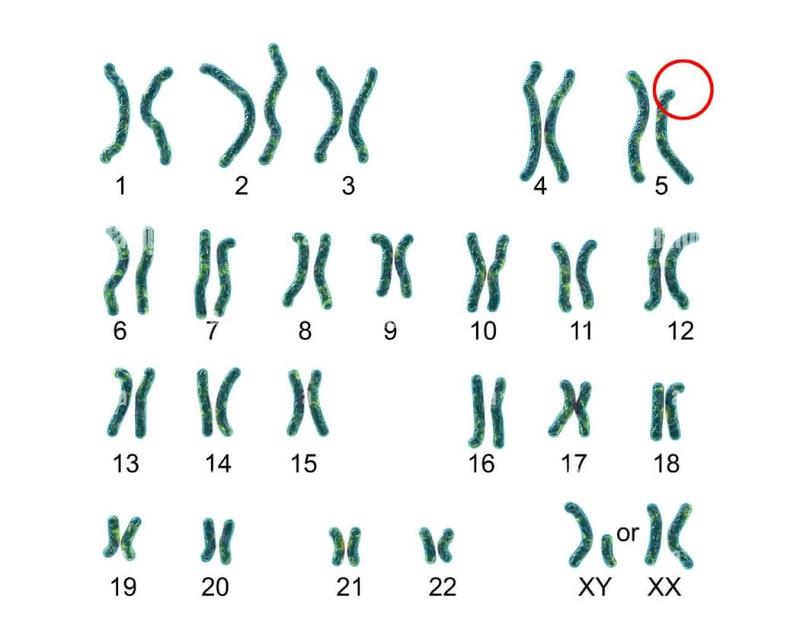Cat meow syndrome: Causes, symptoms, diagnosis and treatment

Cat meow syndrome is one of the rare genetic disorders in children. Therefore, the concept of cat meow syndrome is still a new concept to many people. So what is cat meow syndrome? What are the typical symptoms of this syndrome? How is the diagnosis and treatment? All will be in today's health article of SignsSymptomsList.
According to statistics, cat meow syndrome affects about 1/50000 children. Children with this syndrome often have limited intellectual, linguistic and motor skills. To better understand this syndrome, let's first learn a little bit about the cat meow syndrome with SignsSymptomsList!
What is cat meow syndrome?
The cat meow syndrome is scientifically known as Cri du chat syndrome. In addition, this syndrome is also known by some other names such as 5p chromosome deletion syndrome, 5p minus syndrome, CdCS syndrome or Lejeune syndrome. This is a rare genetic disease but one of the most common chromosomal abnormalities, namely the loss of a short arm of chromosome 5.
According to statistics, cat meow syndrome occurs with a rate ranging from 1/15000 - 1/50000 live births. And the rate of this disease is usually higher in girls than boys. In addition, some cases may go undiagnosed, making it difficult to determine the true frequency of this disorder in the population.
Cat meow syndrome was first described in the medical literature in 1963 by Dr Lejeune - a French pediatrician and geneticist. And Cri du chat is the French name for cat meow syndrome.
 Cat meow syndrome is a rare genetic disorder
Cat meow syndrome is a rare genetic disorder
What causes cat meow syndrome?
The cause of cat meow syndrome is a loss of a segment in the short arm of chromosome 5. The manifestation as well as the severity or severity of the disease depends on the location and length of the loss.
- According to statistics, 80-85% of these mutations arise randomly during the formation of gametes or zygotes in the early stages. Therefore, parents of children with this syndrome are usually normal people.
- Statistics also show that the remaining 10-15% are due to balanced translocation mutations in both parents, where one segment of chromosome 5 exchanges with another chromosome. The parents will have a normal phenotype because the genetic material remains unchanged. However, either parent will pass on the abnormal chromosomes to the child, including the presence of the missing chromosome 5, combining with the normal chromosome 5 from the other parent and giving birth. The child has cat meow syndrome.
 Cat purr syndrome is the result of a deletion in the short arm of chromosome 5 .
Cat purr syndrome is the result of a deletion in the short arm of chromosome 5 .
Symptoms of cat meow syndrome
The clinical features, severity, and progression of cat meow syndrome vary widely from person to person. The larger the chromosome deletion, the more severe the symptoms. Specifically, children with cat meow syndrome may have the following symptoms:
- The first, easy to notice and characteristic sign of this syndrome is that the infant has a monotonous, high-pitched cry or cry similar to a cat's meow. However, as children get older, this sign becomes less and less obvious. According to statistics, by the age of 2, about a quarter of children no longer cry like this.
- Low birth weight, growth deficiency, decreased muscle tone, small head circumference.
- Distinctive facial features: Unusually round or plump face, wide nose bridge, eyes far apart, slanted eyelid folds, deep inner upper eyelid folds, crossed eyes, low ears accompanied by an abnormally small jaw, high palate and incomplete closure, cleft lip , etc. Some features that may change as the child matures include an elongated face, higher bridge of the nose, folds in the upper eyelids fading…
- Newborns may have difficulty feeding due to weak muscle tone, poor feeding, gastroesophageal reflux , recurrent infections, etc., usually lasting the first few years of life. In one study, only 50% of children with meowing syndrome were able to feed themselves with a spoon by the time they were over 3 years old.
- About 15-20% of babies with meow syndrome have congenital heart defects . Children with scoliosis are at risk for ear infections and hearing loss.
- Intellectual: Most children with this syndrome have mental retardation as well as motor skills, delay in walking, speech delay, difficulty in expressing language. In particular, most children with this syndrome have difficulty concentrating, a few are hyperactive. In addition, children also have behavioral abnormalities such as repeating a certain behavior, self-harming, hitting, biting or scratching themselves...
- Some less common symptoms that children with cat meow syndrome may still experience include: Inguinal hernia , kidney and urinary tract abnormalities, sticky fingers, nearsightedness, cataracts, urinary tract infections recurrent respiratory infections, recurrent intestinal infections, etc.
 A baby's cry like a cat's meow is a typical symptom of this syndrome
A baby's cry like a cat's meow is a typical symptom of this syndrome
Methods of diagnosis and treatment of cat meow syndrome
Here are some ways to diagnose and treat cat meow syndrome:
Diagnostic methods: Currently, with the development of medicine, genetic testing methods are born to help detect abnormalities early in pregnancy. To diagnose cat meow syndrome early, doctors need careful clinical assessment to identify the characteristic manifestations and perform some additional tests such as karyotyping, karyotyping. NIPS test and fluorescence in situ hybridization (FISH) to detect deletion mutations in the short arm of chromosome 5.
Treatment methods: Currently, there is no definitive cure for cat meow syndrome. Treatments only help control symptoms. Treatment for Cri du chat syndrome depends on each person's specific symptoms. Achieving effective treatment requires a coordinated effort in planning as well as treatment by a team of specialists, pediatricians, surgeons, orthopedists, cardiologists, physicians. neurologist, speech therapist, physiotherapist, and several other doctors.
In fact, crying like a cat meows will go away with time. However, other symptoms of this syndrome also need to be treated to avoid affecting the health and life of the child later. Early intervention is very important for children with this syndrome to help them develop in the best way.
Early interventions include: Special remedial education, speech therapy, physical therapy, etc. Surgery can address a wide range of symptoms associated with meowing syndrome such as heart defects. congenital, scoliosis, strabismus, cleft palate, cleft lip, ...
 NIPS prenatal screening can detect microchromosomal deletion syndromes in the fetus
NIPS prenatal screening can detect microchromosomal deletion syndromes in the fetus
Above is all the information surrounding the cat meow syndrome that SignsSymptomsList has compiled to share with readers. Hopefully, through this article, readers can better understand this syndrome. Wish you a lot of health reading and don't forget to continue to follow the Pharmacy's website to update more useful articles.